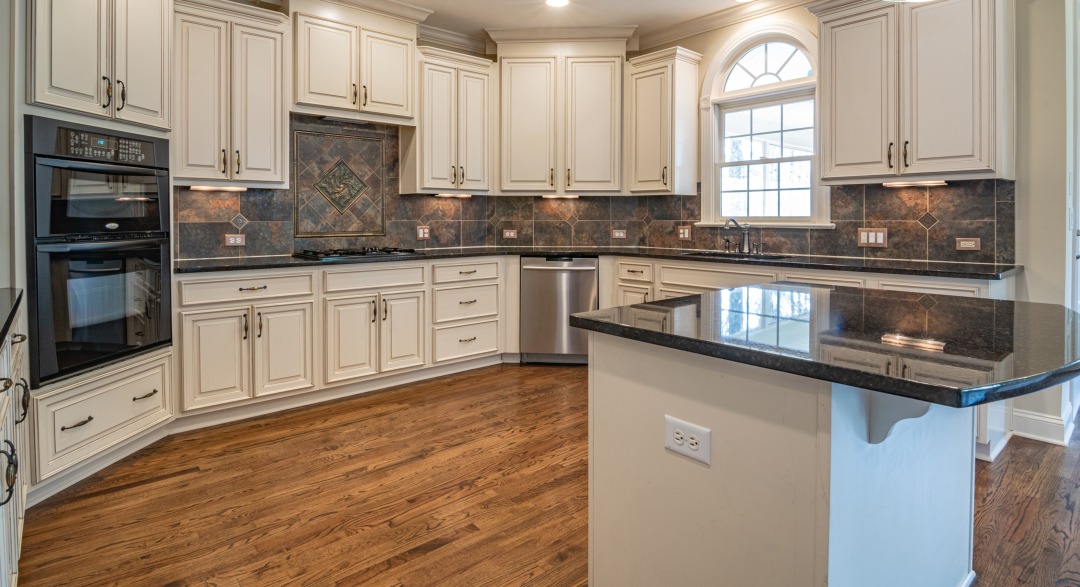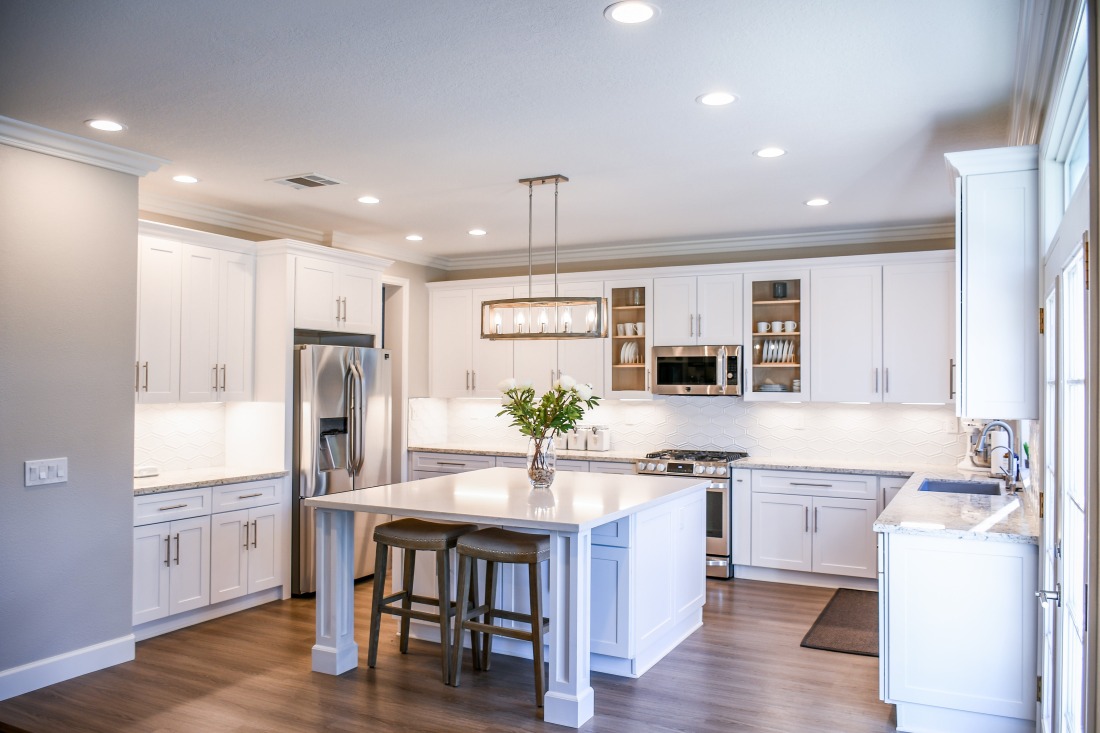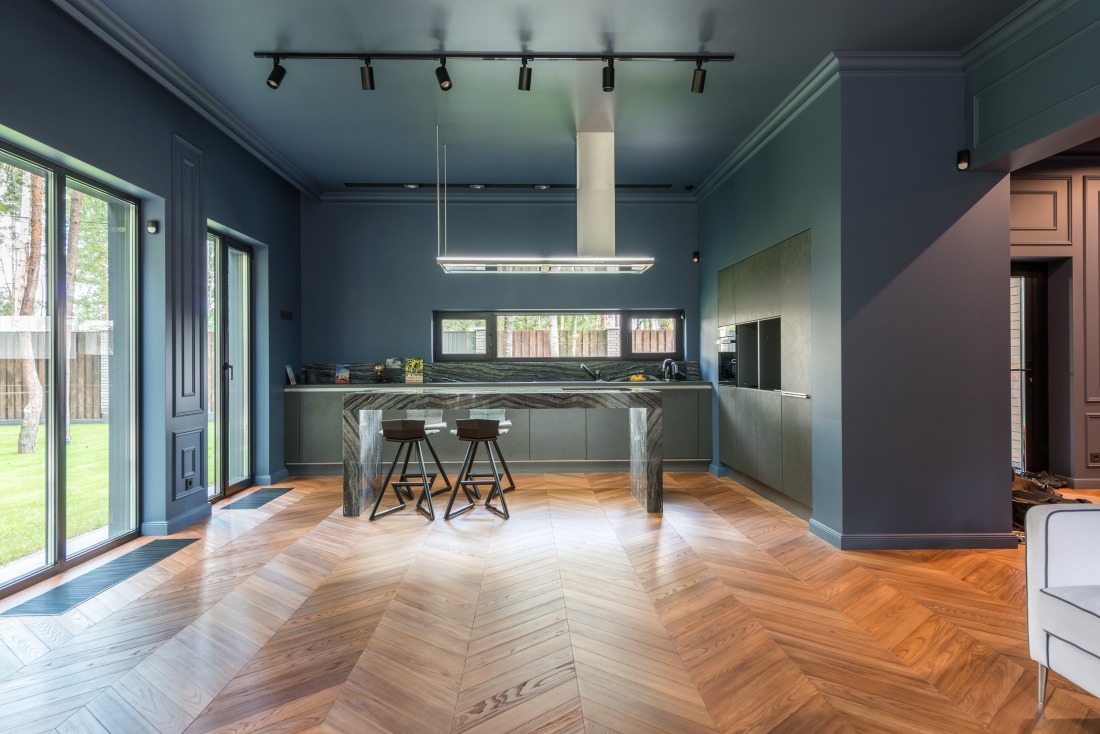
Herringbone Flooring For Kitchen
January 26, 2024Craving a kitchen that blends timeless elegance with effortless living? Unleash the magic of herringbone flooring! Easy Step's revolutionary LVT redefines this classic pattern, offering beauty that's durable, stylish, and easy to care for. Upgrade your space from floor to fork – order your free samples today and step into your dream kitchen!
Importance of choosing the right flooring option for a kitchen
The flooring in a kitchen plays a crucial role in both functionality and aesthetics. It is important to choose the right flooring option that can withstand the high traffic, spills, and constant cleaning that a kitchen experiences. Herringbone vinyl flooring is an excellent choice for kitchen flooring due to its versatility, durability, and cost-effective nature.
Herringbone vinyl flooring is highly versatile, meaning it can complement any style and shape of kitchen. It is also available in a wide range of modern and traditional colors, making it easy to find the perfect match for any kitchen décor.
In addition, herringbone vinyl flooring is incredibly durable, able to withstand the wear and tear of a busy kitchen. It is resistant to water, scratches, and stains, making it an ideal choice for a space where spills and messes are common.
Furthermore, herringbone vinyl flooring is cost-effective, providing a high-quality appearance at a fraction of the cost of traditional flooring materials. This makes it a practical choice for homeowners looking to update their kitchen without breaking the bank.
Overall, choosing the right flooring option for a kitchen is essential, and herringbone vinyl flooring offers the perfect blend of durability, versatility, and cost-effectiveness.
Introduction to herringbone flooring and its benefits
Herringbone flooring has a rich history dating back to 16th-century France, where it was first used in grand parquet flooring designs. This classic pattern consists of rectangular tiles or wooden planks arranged in a zigzag pattern, creating a visually striking and elegant effect.
In modern design, herringbone flooring has experienced a resurgence in popularity due to its timeless appeal and versatility. Its benefits include adding a sense of sophistication and refinement to any space while also infusing a touch of casual charm.
Herringbone flooring can be used to elevate casual areas such as living rooms and kitchens, as well as add an air of distinction to more formal spaces like dining rooms and entryways. It can also create a sense of flow and movement in a room, making it ideal for open-concept layouts.
For maximum impact, herringbone flooring can be installed in various settings, including residential homes, offices, and commercial spaces. This pattern can be used with a wide range of flooring materials, including hardwood, laminate, and tile, making it a versatile choice for any design aesthetic. Whether used in traditional or contemporary settings, herringbone flooring adds a touch of timeless elegance and sophistication to any space.
Understanding Herringbone Flooring
Herringbone flooring is a classic and timeless pattern that has been used in homes for centuries. It is characterized by its distinctive V-shaped design and is a popular choice for adding a touch of elegance and sophistication to any space. In this article, we will explore the history of herringbone flooring, its unique features, and the benefits of choosing this style for your home. We will also discuss the different materials and colors available, as well as the installation process and maintenance tips for keeping your herringbone flooring looking beautiful for years to come. Whether you have a traditional or modern interior design, understanding herringbone flooring will help you make an informed decision when it comes to selecting the perfect flooring for your home.
Definition and origin of herringbone pattern
The herringbone pattern is a distinctive V-shaped weaving pattern that originated in the Roman Empire and has been used in various forms of art, design, and architecture for centuries. The pattern's name comes from its resemblance to the skeleton of a herring fish. The herringbone pattern is often confused with the chevron pattern, but the main difference lies in the way the individual pieces are cut and laid. In a herringbone pattern, the planks are cut at perfect 90-degree angles and laid in a staggered zigzag design, creating a continuous flow and a less rigid appearance. On the other hand, in a chevron pattern, the planks are cut at an angle and laid in a continuous zigzag pattern without the staggered joints.
Herringbone flooring, in particular, is known for its timeless and elegant look, as well as its durability. Its unique 90-degree-angle joints create a visually appealing pattern that can make a space feel larger and more dynamic. This classic pattern has made a resurgence in interior design and is now a popular choice for hardwood, tile, and laminate flooring. The herringbone pattern's ability to create a flowing, less rigid design makes it a versatile and stylish option for both traditional and modern spaces.
How herringbone pattern is achieved in wood flooring
The herringbone pattern in wood flooring is achieved by laying out the planks in a zig-zag pattern, alternating the direction of each plank. This creates a visually appealing and timeless design that adds character to any space. For a more traditional look, it's best to use narrower planks in the herringbone pattern. On the other hand, wider planks can create a more modern aesthetic. When choosing the width of the planks, it's important to consider the existing flooring. If the adjacent rooms have older, narrow planks, it's best to choose a width that complements them.

Installation Process of Herringbone Wood Floors in Kitchen
When it comes to adding warmth and character to a kitchen, herringbone wood floors are an excellent choice. The installation process of these unique floors requires careful planning and precision to ensure a successful and long-lasting outcome. From preparing the subfloor to laying the herringbone pattern and finishing the wood, there are important steps to follow to achieve a beautiful and durable floor in the kitchen. With the right tools, materials, and attention to detail, homeowners can transform their kitchen with the timeless elegance of herringbone wood floors.
cohesive look throughout the space. By carefully selecting the width and layout of the wood planks, homeowners can achieve a stunning herringbone pattern that adds elegance and visual interest to their wood flooring.
Advantages of herringbone flooring in kitchen
Herringbone flooring is a popular choice for kitchen flooring due to its numerous advantages. Its versatility allows it to seamlessly blend into any style of kitchen, whether it's traditional, modern, or somewhere in between. Herringbone flooring has the unique ability to brighten and lighten small kitchen spaces, making them feel more open and airy. On the other hand, it also complements larger kitchens or open-plan areas by adding a touch of elegance and sophistication.
Practically, herringbone flooring is durable and easy to clean, making it a practical choice for the high-traffic area of the kitchen. Its aesthetic appeal is undeniable, adding visual interest and depth to the space. Its timeless appeal and classic look make it a popular choice for kitchen renovations and remodels, as it effortlessly elevates the overall design of the kitchen. With herringbone flooring, homeowners can achieve a balance of practicality and style, making it an ideal option for kitchen flooring.
Types of Herringbone Wood Flooring
Herringbone wood flooring is a classic and timeless choice for any home or commercial space. Its distinctive pattern and durability make it a popular option for homeowners and designers alike. There are several types of herringbone wood flooring available, each offering unique features and benefits. In this article, we will explore the different types of herringbone wood flooring, including solid wood, engineered wood, and laminate options. We will also discuss the various colors, finishes, and installation methods available for herringbone wood flooring, providing valuable insight for anyone considering this stylish and versatile flooring option.
Exploring different wood species for herringbone floors
Herringbone floors are a popular and classic choice for adding timeless elegance to any space. When it comes to choosing the right wood species for herringbone floors, there are several options to consider, each with its own unique characteristics and benefits.
Oak is a popular choice for herringbone floors due to its durability and natural resistance to wear and tear. It comes in a range of color variations, from light to dark, and is known for its
Engineered vs. solid herringbone wood floors
Engineered herringbone wood floors are composed of multiple layers of wood or plywood, topped with a layer of solid hardwood. This construction makes them more resistant to moisture and temperature changes, resulting in increased durability compared to solid herringbone wood floors. However, solid herringbone wood floors are more durable in the long run and can be sanded and refinished multiple times.
In terms of cost, engineered herringbone wood floors are generally more affordable than solid ones, making them a budget-friendly option for homeowners. Additionally, their easier installation process, which often involves clicking or gluing the planks together, can result in lower labor costs compared to the more complex installation of solid herringbone wood floors.
For those seeking a traditional and timeless look, solid herringbone wood floors offer the authentic beauty of natural hardwood. However, they are more susceptible to moisture and temperature fluctuations, making them less suitable for areas with high humidity. On the other hand, engineered herringbone wood floors are more versatile in this regard.
Key considerations when choosing between the two types include the desired level of durability, budget constraints, and the specific installation requirements for the home. Ultimately, both options offer unique benefits and drawbacks that should be carefully weighed before making a decision.
Pronounced grain patterns
Walnut is another popular choice for herringbone floors, prized for its rich, warm tones and distinctive grain patterns. It offers a luxurious and sophisticated look, making it an ideal choice for upscale spaces.
Maple is a durable and versatile option for herringbone floors, known for its light, creamy tones and subtle grain patterns. It offers a bright and airy look, perfect for creating an open and inviting atmosphere.
Cherry wood is prized for its rich, reddish-brown hues and smooth, fine grain patterns, adding warmth and character to herringbone floors.
Ash is a durable and resilient wood species known for its light color variations and prominent, bold grain patterns, making it a striking choice for herringbone floors.
When it comes to maintenance, all wood species used for herringbone floors require regular cleaning and occasional refinishing to maintain their beauty and durability. By carefully considering the unique characteristics of each wood species, you can choose the perfect option for your herringbone floors, adding lasting beauty and charm to your space.
Preparing the subfloor for installation
Before installing Breckon flooring, it is crucial to ensure that the subfloor is flat and free of any debris. A flat subfloor prevents any bumps or unevenness that could cause the flooring to buckle or wear unevenly over time. It is also important to check for rot, dampness, and contaminating residues, as these can compromise the integrity of the flooring installation.
Acceptable subfloor materials for Breckon flooring include plywood, OSB (oriented strand board), concrete, and existing flooring materials such as vinyl or linoleum (if they are in good condition). Carpet is not suitable as a subfloor material for Breckon flooring due to its soft and uneven nature, making it unsuitable for proper installation.
In addition to being flat and debris-free, the subfloor must also meet certain flatness requirements for Breckon installation. The maximum allowable unevenness for Breckon flooring installation is typically 3/16 inch over a 10-foot span. It is important to ensure that the subfloor meets this requirement to ensure a smooth and successful installation of Breckon flooring.
Tools and materials required for installation process
To install wood-effect flooring in the kitchen with proper expansion gaps, the following tools and materials are essential:
1. Wood-effect flooring
2. Underlayment
3. Tapping block
4. Rubber mallet
5. Spacers
6. Circular saw
7. Tape measure
8. Pencil
9. Safety glasses
10. Knee pads
11. Hammer
12. Utility knife
13. Level
14. Pry bar
15. Chalk line
16. Vacuum cleaner
Step-by-Step guide to installing
herringbone wood floors
A step-by-step guide to installing herringbone wood floors:
1. Choosing the Right Width: Select the width of the herringbone wood planks based on the size of the room and the overall aesthetic you want to achieve. Narrow planks can create a more traditional look, while wider planks can give a more modern feel.
2. Determining the Cost: Calculate the cost of materials and labor for the herringbone wood floor installation, including the cost of the wood planks, underlayment, adhesives, and any additional tools or equipment needed.
3. Selecting the Appropriate Installation Method: Decide whether to use a glue-down method, nail-down method, or floating installation for the herringbone wood floors, based on the subfloor, location, and personal preference.
Selecting the Right Location: Choosing the right location for herringbone floors is crucial, as it can elevate the space and create a stunning visual impact. Herringbone wood floors are often used in entryways, living rooms, and dining rooms to add a touch of elegance and sophistication to the space. The unique pattern can make a small room appear larger and add a sense of movement and flow to the area.
In conclusion, installing herringbone wood floors involves selecting the right width, determining the cost, and choosing the appropriate installation method. The location of these floors is crucial, as it can significantly enhance the overall look and feel of the space.

Styling Options with Herringbone Wood Floors in Kitchen
When it comes to kitchen design, the flooring choice can make a huge impact on the overall look and feel of the space. Herringbone wood floors are a popular option for adding warmth and elegance to a kitchen. The unique pattern adds visual interest and can complement a variety of design styles. In this article, we will explore different styling options for herringbone wood floors in the kitchen, from modern and minimalist to traditional and rustic. Whether you're looking to create a sleek and contemporary kitchen or a cozy and inviting space, herringbone wood floors offer a versatile and timeless flooring option.
Pairing herringbone flooring with white cabinets for a classic look
When pairing herringbone flooring with white cabinets, the aim is to create a classic look by balancing warmth and contrast through different wood finishes. The timeless appeal of this combination lies in its versatility, as it can effortlessly complement a range of design styles.
For a classic and elegant result, consider using warm-toned wood finishes such as oak, walnut, or cherry for the herringbone flooring. These rich wood tones create a beautiful contrast against the clean, crisp look of white cabinets, adding depth and character to the space. Alternatively, lighter wood finishes like maple or ash can also be used to achieve a more modern and airy feel while still preserving the classic aesthetic.
Ultimately, the pairing of herringbone flooring with white cabinets offers a versatile canvas for any interior style. Its timelessness ensures that the combination will remain fresh and stylish for years to come, making it a reliable choice for homeowners looking to create a classic yet contemporary look in their space.
It is crucial to ensure the correct installation tools and materials are used to achieve a proper fit and avoid any potential damage. When laying wood-effect flooring, it is important to leave sufficient expansion gaps, as instructed by the manufacturer. These gaps allow for natural expansion and contraction of the flooring with changes in temperature and humidity. Following the installation instructions carefully will help to achieve a professional and durable finish in the kitchen.
Unlock the Timeless Beauty of Your Kitchen with Easy Step Herringbone. Step into Elegance Today!
Herringbone's unique pattern conceals spills and hides everyday wear and tear. Choose from a stunning range of colors and styles to perfectly match your kitchen aesthetic.
- Visit our website today!
- Order yours today and experience the quality and beauty of Easy Step firsthand.





